|


by William Hutton
March 7, 2002
Last Updated: May 08, 2003
from
HuttonCommentaries Website
The Demise of
The Current Sea-Floor Spreading And Plate-Tectonics Theory
To geologists it is no longer a hypothesis. It is now a theory.
Every Earth scientist believes it is true. Right? And what is “it”?
What I’m talking about is the theory of sea-floor-spreading and
plate tectonics.
As a result of a comprehensive review published late last year, sea
floor spreading and its plate tectonics corollary are shown not to
explain correctly the origin of our planet’s ocean basins and
continents. And what if the current “theory” is incorrect? If it
proves to be wrong, a huge barrier is removed to the acceptance of
the Cayce readings’ story on the lost continents of Atlantis and
Lemuria.
No longer will it be delusional to consider vertical crustal
movements to explain the origin of Earth’s ocean basins. “Elevator
tectonics” will be in, and “shuffle-board” (plate) tectonics will be
out, almost entirely. Although sea-floor spreading will still have a
small place in geoscientists’ understanding of certain aspects of
the origin and maintenance of continents and ocean basins, the
really big picture, of elevation of ocean floors and - to a lesser
degree - continents will rest upon a model that is driven by mantle
surges.
Geologists know, for example, that a global surge of Earth’s mantle
began in Mesozoic time. At its peak in the Cretaceous period, ocean
floors in the Atlantic and Pacific were elevated above sea level.
The resulting oceanic continents were full of volcanic terraces. The
Mesozoic mantle-surge event was then followed by gradual cooling and
collapse of the oceanic volcanic edifices.
To understand this radical departure in our understanding of mantle
convective behavior, and its effects on Earth’s crustal structures,
we need to review briefly the current model of sea-floor spreading
and plate tectonics.
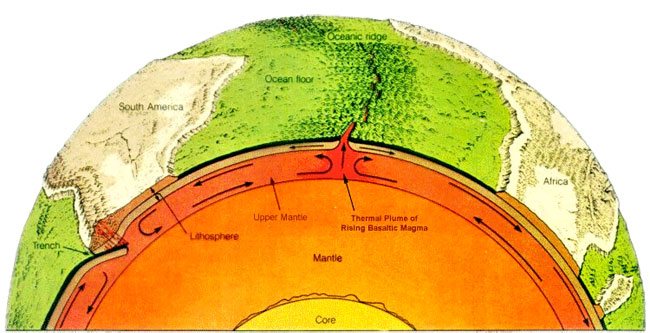
Fig 1. The
conventional model of sea-floor spreading.
Current Sea-Floor Spreading Hypothesis
As shown in Figure 1, geologists currently believe that thermal
plumes of hot magma are semi-continuously moving upward beneath
ridges found in all of the world’s oceans. This semi-fluid basalt
rock is exuded here and there along a ridge crest. The process
forces sea-floor crustal plates on either side away from the ocean
ridge and toward the continents. The continents may either be
carried along by the adjacent sea floor, or the spreading sea floor
may under-thrust a relatively immovable continent. See Figure 1 for
examples of both hypothetical situations.
A given pulse of magma, over a relatively short distance along an
ocean ridge, becomes magnetized when the semi-molten material cools
below a specific temperature. Iron minerals in the basalt magma are
then frozen in the rock and they point in the direction of the
prevailing magnetic field. Geophysical survey methods can then used
to detect whether the sea-floor rocks were magnetized in a normal
geomagnetic field (like today’s) or in a reversed field. Because
Earth’s magnetic field is moving and/or reversing through time,
magnetic orientation directions of basalt exudations allow the
sea-floor rock slabs be correlated with one another. This process
results in a sort of “tape-recording” of the formation and movement
of rock masses of the spreading sea floor - or so the hypothesis
goes.
The crystallized rock of each new exudation then splits in two along
an axis coinciding with the central valley of the ocean ridge. In
Figure 2, two brown-colored slabs of newly crystallized, ocean-floor
basalt are separated by a black line representing the central valley
of a mid-ocean ridge.
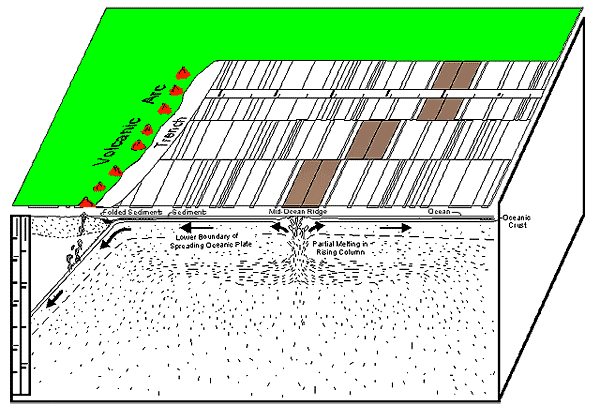
Fig. 2. Magnetic
stripes and the current sea floor spreading model. Sea-floor stripes
are formed by ocean-floor magma that cooled and crystallized in a
specific magnetic-field orientation. These rock masses may be offset
later along transform faults or large-scale fractures that run
perpendicular to the ocean ridge.
(Fig. adopted
from a page on the U.S. Geological Survey’s website.)
The presence of magnetic stripes on the ocean floor has been thought
to be prima facie evidence for sea-floor spreading, and the basis
for the plate tectonics (PT) model of crustal motion. Note in the
diagram that segments of magnetic stripes of the same age are
confined on either end by transform faults that run perpendicular to
the ocean ridge. It was assumed early-on in the development of the
PT theory that striped segments of the same age were offset from one
another due to different amounts of subsequent effusions of magma at
the ridge crest. Larger effusions would push the plates farther
apart than would smaller ones.
Here then, is an abbreviated description of the sea-floor-spreading
and plate tectonics model for the dynamic behavior of the crust and
underlying mantle. Most geologists have assumed this model correct
for the last 25 years or so. Its acceptance by geoscientists has,
quite naturally, caused great difficulty for those who want to
accept the Cayce readings’ story of Atlantis and Lemuria. How could
there ever have been continents in the Atlantic or the Pacific
oceans where there are now ocean floors? For doesn’t all the
evidence point to stability of the submerged ocean floors and to the
basically horizontal movement of crustal plates the world over?
Problems
With The Conventional Model, According to Prof. MacKenzie Keith
(Now Deceased)
Now comes a convincing treatise on what may really be happening in
the realm of global crust and upper-mantle dynamics. I will be
basing the rest of this article on MacKenzie Keith’s comprehensive
examination of sea floor spreading and plate tectonics, published
last fall.1 His paper has about 300 references and is the product of
Keith’s life of research and teaching in the field, laboratory, and
classroom. Upon his death last year he was Emeritus Professor of
Geochemistry at Pennsylvania State University.
Dr. Keith begins modestly by saying that although the essential
features of the PT hypothesis are widely accepted, some aspects of
the model are open to question. Quite simply, they conflict with
known properties of Earth’s materials and the global crust/mantle
dynamic system. Keith’s first objection is to the hypothesis that
the plates are internally rigid. If a stress is applied to one side,
it is transmitted to the opposite side with no deformation of the
plate interior. But this is inconsistent with the results of
experiments on rock strength and with the factors that govern the
strength of large masses of rock over geologic time. Actually, large
rock masses are weak, and they deform under the influence of heat.
Keith next states that there is a need to re-examine the hypothesis
of upwelling of magma beneath the axis of an ocean ridge. Computer
models of heat flow beneath ocean ridges are based upon evidence of
a wide plume of ascending molten basalt to produce the magma
effusions along the ridge. But how, asks Keith, can broad plumes
generate the narrow zone of axial ridge volcanism, the “knife-edge”
separation of adjacent flow regimes on either side of a transform
fault (see Fig. 2), and the unbelievable “overlapping spreading
centers” advocated by some geologists?
Further questions are related to the concept of ocean floor
spreading and the tape-recorder model for generating the oceanic
magnetic stripes. Different rock chemical compositions are often
found on opposite flanks of the ocean ridges. The rocks should be of
the same composition if they come from the same magma effusion. And
what of the failure to find the required narrow zone of crustal
accretion, with the property of dividing neatly so that matching
halves move to either side?
Keith now moves ahead with certainty to answer these questions. He
asserts that no spreading is required to account for the observed
sea-floor features. Instead, the oceanic magnetic stripes can be
explained by narrowing of a formerly very wide mid-ocean volcanic
zone and by consequent crestward migration of something he calls the
“blocking temperature,” discussed below. He hypothesizes that a
Mesozoic surge of mantle flow and volcanic-zone expansion that
peaked in Cretaceous time (between 66 and 144 million years ago)
produced a different “volcanic face” on Earth. Elevated ocean floors
then began to collapse over millions of years, leading to the
features we find today.
Finally, Keith postulates an alternative model of upper mantle flow
to the current one. His conceptual model involves mantle upwelling
beneath continents, flow of mantle from beneath continents to
beneath oceans (for Atlantic Ocean type margins), and convergent
sub-ocean mantle flow toward the axes of mid-ocean ridges. He
asserts that the mid-ocean ridges are principal boundaries of
convection cells in the mantle. He then summarizes a wide variety of
information in the rest of his review paper to conclude that “the
weight of evidence clearly supports the alternative model [his
model] and is contrary to the [sea-floor] spreading model of plate
tectonics.”
Alternative Model of Mantle/Crust Dynamics
How the Keith Model Works
We’ll begin by considering what happens
relative to the mid-Atlantic ridge (MAR) of the Atlantic Ocean in
the vicinity of the now submerged Reykjanes Ridge south of Iceland.
Instead of hot, plastic upper mantle material having flowed away
from the mid-ocean ridge, as shown in Figure 1, it has flowed toward
it and elevated the entire ocean floor, as shown in
Figure 3.
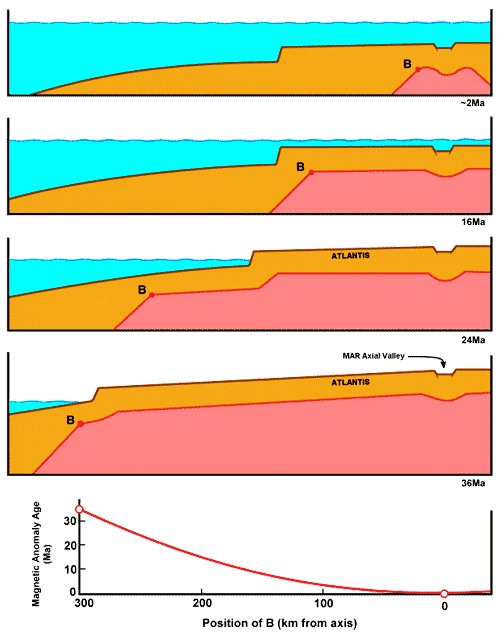
Fig. 3.
Simplified sequence of a series of cross-sections representing the
cooling and sinking of Reykjanes Ridge,
part of the MAR running
southwest of Iceland (Fig. 4).
This figure is modified from Keith,
2001, Fig. 11.
The sections show Keith’s alternative model for
generating oceanic magnetic stripes by ridge cooling
following a
Cretaceous-age peak in volcanic activity.
The three early stages of
cooling (and migration of blocking temperature isotherm B)
represent
conditions at magnetic anomaly ages 36, 24, and 16 million years ago
(Ma).
The blocking temperature isotherm is the temperature at which
magnetic minerals acquire
either normal or reverse remnant magnetism
and thus record the Earth’s geomagnetic field orientation.
I have taken the liberty on
Figure 3 of
labeling the emerged part of the Reykjanes Ridge “Atlantis.” There
is truly no better name to use for this formerly elevated, now-
submerged oceanic continent. For actual physical evidence that parts
of the mid-Atlantic ridge were above water during recent time, see
below.
To continue now to elucidate Keith’s explanation of the origin of
the magnetic stripes on the ocean floor, we quote from his p. 268,
as follows.
“An essential feature of the
proposed ocean ridge system is that all of the abnormal features
that resulted from the Mesozoic surge of mantle flow:… uplift of
the ridge, accelerated volcanism, broadening of the active
volcanic zone, were subject to gradual Mesozoic to Recent
relaxation and retreat, toward a steady-state system, a
predictable effect of the slowing of convective overturn and
volcanism, and the gradual diminishing, via return-flow gyres,
of the accumulated large volume of sub-ridge subduction
mixtures. The age-denominated sequence of magnetic anomalies,
conventionally attributed to sea-floor spreading, is proposed to
result, instead, from gradual narrowing of the active volcanic
zone.”
Magnetic Banding According to Keith’s
Cooling Model. Figure 4 may help to explain the above quote, as it
applies specifically to magnetic banding. The basic idea is that a
narrowing of the zone of mid-ocean ridge basalt volcanism (Fig. 4,
reddish portions of bars) will be accompanied by crestward migration
of the blocking temperature isotherm (Fig. 3). This is the
temperature at which the magnetic minerals acquire remnant magnetism
and thus record reversals of Earth’s magnetic field.
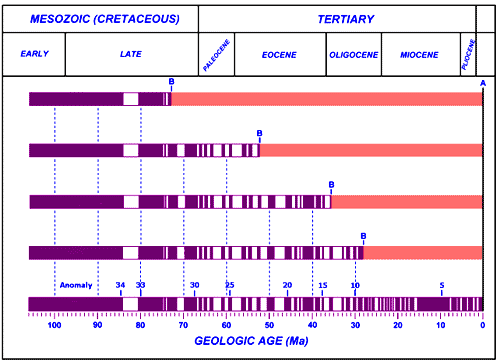
Fig. 4.
Idealized snapshots of one side of a mid-ocean ridge, to show the
development of oceanic magnetic stripes, from the mid-Cretaceous
period of Mesozoic time to the Present, as a result of gradual
narrowing of the active mid-ocean volcanic zone. A is the ridge
axis. This diagram, modified from Keith, Fig. 10, shows migration of
the blocking temperature isotherm B. The reddish color to the right
of B indicates the portion of the ridge for which the principal
magnetic source remains above the blocking temperature.
[The
geomagnetic polarity (normal or reverse) and the geologic time scale
are from D. Kent and F. Gradstein,1986, “Jurassic to Recent
chronology,” in The Western North Atlantic Region. Geol. Soc.
America, Geology of North America, v. M, pp. 45-50, Plate 1.]
Keith proposes that fracture zones and
transform faults (see Fig. 2) are ocean-floor surface expressions of
the boundaries of “convective rolls” in the underlying mantle. Such
rolls are judged to be,
“the principal form of secondary
convection within the upper boundary layer of sub-ridge mantle,
a low-viscosity region estimated at 75-125 km thick….”
(p. 240).
Translating Keith’s words for the
non-geologist reader, imagine that the primary, heat-driven flow of
the uppermost mantle is outward from beneath a continent like
Africa, and toward the MAR. As the mantle moves there is subsequent
heat loss in the oceanic region. In the downstream region of lateral
flow and heat loss there is development of an upper mantle boundary
layer that eventually becomes unstable and yields a regular pattern
of upper mantle “rolls” aligned in the direction of principal flow.
Boundaries that develop along each edge of a roll result in ocean
floor fractures and transform faults. (A transform fault is merely a
near-vertical surface over which one side slips past the other, but
is unique in that the displacement suddenly stops or changes form).
To end his description of the formation of magnetic stripes on the
sea-floor, Keith cites relevant laboratory, numerical modeling, and
field measurements. He concludes by saying that the evidence is
consistent with his proposed upper-mantle convergent flow and
contrary to the plate tectonics model of mid-ocean upwelling and
divergent flow.
To quote Keith on the implications of Figures 3 and 4,
“the proposed ridge-cooling model of
magnetic stripe formation does not involve spreading or
continental splitting, and there are no implications regarding
continental drift, except that the continents are presumed to be
floating in the mantle, each focusing one or more upwelling
plumes, and free to move in response to changes in the global
[mantle] convection pattern. The principal continental drift
will be related to mantle surge episodes, and there will be a
strong tendency for continents to re-establish their separate
positions as part of a return to a steady-state flow regime.”
Keith’s Hypothetical Model of Proposed
Mid-Ocean Ridge Dynamics and Structure
Keith proposes a structure
for a mid-ocean ridge to satisfy geophysical observations and his
intuition about how, dynamically, the ocean-floor crust and
underlying mantle behave. He calls this structure a “flexload
syncline.” A syncline is simply a fold in Earth’s rocks, the core of
which contains younger material and which is generally concave
upward. The adjective flexload is used to emphasize the effects of
gravity-produced flexure on the crustal stress regime. In his
proposed ocean-ridge model, the structure of the crestal zone is
attributed mainly to gravitational deformation that results from two
types of loading: crestward-increasing volcanic loading and downward
increasing densification. Keith cites evidence that major flexload
sinking,
“is not restricted to the near-axial
zone but is broadly effective beneath the ridge flanks and
formerly extended over the full width of Mesozoic to Early
Tertiary ocean ridges.”
What will a cross-section diagram of a
mid-ocean ridge structure look like for Keith’s crustal-collapse-under-cooling
model? Figure 5 gives us the picture.
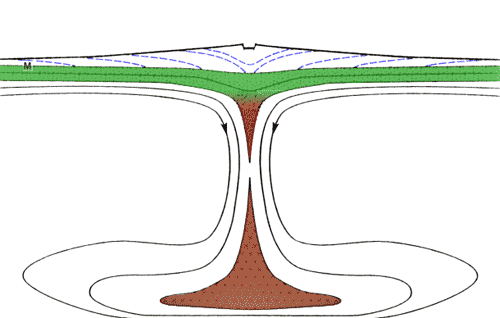
Fig. 5. M.
Keith’s model of proposed mid-ocean-ridge dynamics and structure,
including sub-ridge convergence and downflow,
as adapted from Fig. 4
of his paper.
The thickness of the crust is greatly exaggerated to
show the structure.
This is a “flex load” syncline of former wide
extent that reflects a crestward increase in volcanic loading and
subsidence.
Red
represents the region between the mantle and the sub-axial wedge of
subducted crust, and is a zone of melting.
Blue
lines represent crustal layering, dipping toward the axial valley.
Solid lines
are non-specific isotherms (lines of equal temperature).
Green
represents the low-velocity zone (for seismic wave propagation) that
characterizes crust and mantle mixing.
Brown
indicates basalt-depleted residuum.
“M”
denotes the “Moho,” a boundary that separates the Earth’s crust from
the underlying mantle.
Direct
Evidence of An Emergent Atlantis
Incidental, almost, to Keith’s efforts to buttress one of his points
about a former emergent continent in the Atlantic ocean is the
material that he summarizes on former shallow water or emergent
sites sampled by the Deep Sea Drilling Project (DSDP). The sampling
sites are currently underwater in the region of the Mid-Atlantic
Ridge (MAR). Locations for three of these sites (Keith, 2001, Table
1) are shown by large red dots on Figure 6,
in a relief map of the
Azores.
The red dots are rather large because, while the sampling
coordinates that are listed give degrees north latitude, they do not
give degrees west longitude. It is understood, however, that the
samples were taken in the vicinity of the MAR axial valley, clearly
visible on Figure 6.
Here’s what was found:
-
at point A, at a depth of 12,802 ft: highly
vesicular basalt, weathered and oxidized basalt, and a major gap in
the basal sedimentary section that indicates subaerial erosion
-
at
site B, at a depth of 12,440 ft, basaltic pebbles and weathered and
oxidized basalt were found.
-
at site C, in 12,313 ft of water,
once again basaltic pebbles and weathered and oxidized basalt were
found
All of the above findings are strong indicators of a
formerly
emerged MAR. And they suggest that this volcanic terrain has sunk a
minimum of 12,300 ft since being exposed to the atmosphere. Note
that Keith’s Table 1 lists six additional MAR sampling sites - to the
south of those plotted on our Figure 6 and on down to the equator.
Two of these sampling sites show ridge tops flattened by wave
erosion, one revealed Tertiary-age shallow water sediment, and
another revealed Cretaceous-age shallow water sediment. A final,
rather startling finding consists of canyons and a trellis drainage
system, quite possibly formed subaerially at a depth greater than
9800 ft. The MAR location is between 26º and 27ºN.

Fig. 6.
Physiographic diagram of the Azores region, based on a diagram by B.
Heezen and M. Tharp.
See text for an
explanation of red dots A-C, sites of deep-water sampling of
subaerial material representative of an emergent continent.
(Subaerial
refers to conditions and processes that exist or operate in the open
air on and immediately adjacent to a land surface).
A repository
for the records of the Atlantean civilization may be found in the
area shown by blue shading.
The Atlantean
records repository will be found in a specific temple "where a
portion of the temples may yet be discovered."
(See reading
440-5).
As quoted from Keith (p. 266),
additional evidence of former exposure of the MAR consists of,
“…extensive denudation of oceanic
crust [and] development of deep canyons and trellis drainage
patterns along fault scarps of the MAR (Tucholke et al., 1997).
Tucholke et al. attributed the modified topography to sub-ocean
mass wasting but erosional features … out to about 300 km [185
miles] from the axis, favor Recent subaerial exposure and
erosion of the ridge crest. Former broader subaerial exposure,
and progressive subsidence, is indicated by borehole
intersections at off-axis sites….The stratigraphy of those
borehole sections provides evidence of broad exposure of the
ridge followed by ridge subsidence, [and] narrowing of the
active volcanic zone….”
(Keith, p. 266).
Example of
Cooling, Sinking, and Narrowing of the MAR Through Time
To illustrate the above process in map view, we have modified
Keith’s Figure 9 and turned it into our
Figure 7.
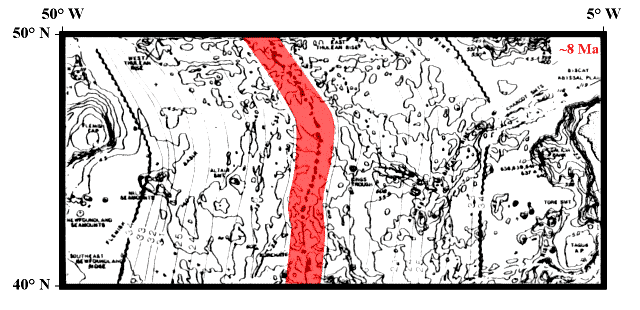

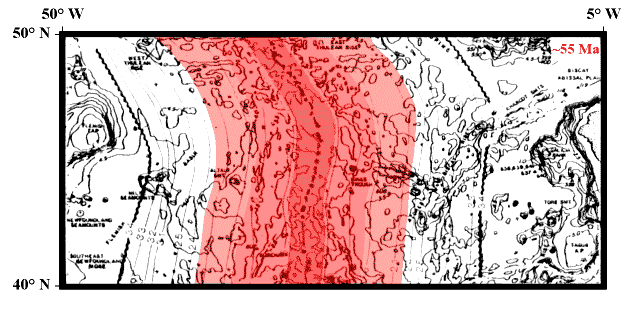
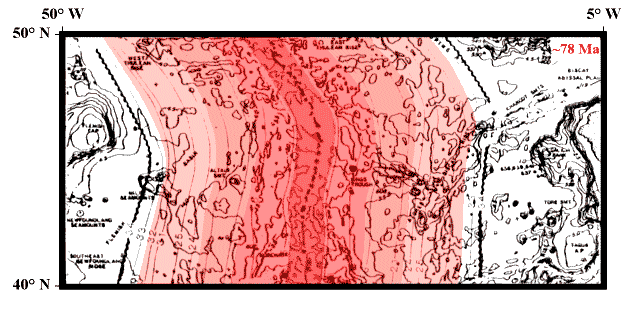
Fig. 7.
Snapshots of a Cretaceous-to-Recent time sequence for a sector of
the sinking Mid-Atlantic Ridge (MAR)
between the Azores and the
Charlie-Gibbs fracture zone,
to show narrowing of the active
volcanic zone,
the proposed mechanism for generating oceanic
magnetic stripes.
The narrowing
color pattern shows the extent of active volcanism at each selected
stage of ridge sinking and cooling.
The trailing of
the crestward-retreating outer limit of volcanism is taken
to be
associated with progressive cooling of the ridge and with the
migrating trace of
the blocking temperature isotherm, at which
remnant magnetism is frozen-in,
thus recording the inclination and
reversals of the Earth’s magnetic field.
Approximate
magnetic anomaly ages in the upper right of each panel are from Kent
and Gradstein (1986).
See caption for
Fig. 4, for complete citation. Ma = millions of years before the
present.
Figure 7 shows four map views of a northern portion of the narrowing
active volcanic zone of the slowly cooling, contracting, and sinking
oceanic continent called here “Atlantis.” The two outermost bands of
the 78 Ma panel are not seen in panel Ma 55. This is because, over
the 23 million years between 78 Ma and 55 Ma, the trailing edges of
the crestward cooling mantle and crust have fallen below the
blocking temperature. These trailing edges have moved progressively
to become the outer edges of the volcanic zone at 55 Ma. In the
process, the formerly plastic rocks of the outermost bands of Figure
7, panel 78 Ma, have crystallized and locked-in the magnetic
orientations of their contained ferromagnetic minerals. This gives
rise to the type of ocean-floor stripes shown in
Figure 2.
To appreciate this process in vertical cross-section view, refer to
Figure 3. Here one finds four snapshots through time of a
cross-section of the western half of the continent. Panel 38 Ma on
Figure 3 corresponds roughly to panel 35 Ma on Figure 7. The
movement of the blocking temperature isotherm B on Figure 3 relates
roughly to the trailing edge of the western red band on panel M 35
of Fig. 7. Note that the highly schematized representations of the
changes in the continent in Figures 3 and 7 cannot capture all
natural variations in land-sea relationships.
Thus, panels 16 Ma and 2 Ma in
Figure 3
show a completely submerged surface of “Atlantis,” and the MAR has
narrowed greatly to a narrow band in panel Ma 8 of
Fig. 7. The
response of rock masses to the contracting oceanic crust and
uppermost mantle is not quite that straightforward, however. One can
assume that local elevations of the sea floor to above-sea-level
positions would have survived generalized continental sinking in
some places, remaining there much longer than indicated by the
diagrams. Thus, the Poseidonis of Zhirov’s research (Fig. 6) and the
Poseidia of the Cayce readings could well have existed above sea
level until as late as about 12,000 years ago.
Summary
of Prof. Keith’s Proposed Global Model
This article would be too long if I were to go into any more of the
aspects of the professor’s marvelous analytical piece of work. The
evidence for emergence of Lemuria will be dealt with in a separate
article. Keith’s application of the results of his literature review
to continental rifts and their associations with oceanic rifts, to
oceanic island-chain dynamics in the Pacific, and to a number of
other important topics like hotspots must also be deferred.
Suffice it to say that Keith believed that the essence of his
proposed global model “is that oceanic crust is a principal
reservoir and that selective recycling of its components is a
counter to weathering and riverine [sediment] transport from
continent to ocean, and a key process in the self-regulating Earth
system” (p. 282). He has little to say about the forces that drove
the Mesozoic mantle surge, other than to say that there is a strong
possibility that it may have been triggered by a cluster of
meteorite impacts in the western equatorial Pacific. These impacts
may have reactivated lower mantle, during a surge-promoted change
from layered to whole-mantle convection. Deep “roll-margin” mantle
recycling associated with the proposed impact-triggered change from
layered to whole-mantle convection, and resultant mantle surge is
deduced to have formed a range of mixtures that apparently
constituted a source of Cretaceous basaltic magma and oceanic crust.
The
Reading’s Atlantis Story Compared With The Keith’s Model
What The Readings Say
Three reading fragments describe the extent
of Atlantis, beginning around 10 million years ago and then down
through time to the days of Amilius, which “time” may have begun
some 200,000 years ago.
Describe the earth’s surface at the
period of the appearance of the five projections.
A This has been given. In the first, or that known as the
beginning, or in the Caucasian and Carpathian, or the Garden of
Eden, in that land which lies now much in the desert, yet much
in mountain and much in the rolling lands there. The extreme
northern portions were then the southern portions, or the polar
regions were then turned to where they occupied more of the
tropical and semi-tropical regions; hence it would be hard to
discern or disseminate the change. The Nile entered into the
Atlantic Ocean. What is now the Sahara was an inhabited land and
very fertile. What is now the central portion of this country,
or the Mississippi basin, was then all in the ocean; only the
plateau was existent, or the regions that are now portions of
Nevada, Utah and Arizona formed the greater part of what we know
as the United States.
That along the Atlantic board formed the outer portion then, or
the lowlands of Atlantis. The Andean, or the Pacific coast of
South America, occupied then the extreme western portion of
Lemuria. The Urals and the northern regions of same were turned
into a tropical land. The desert in the Mongolian land was then
the fertile portion. This may enable you to form SOME concept of
the status of the earth’s representations at that time! The
oceans were then turned about; they no longer bear their names,
yet from whence obtained they their names? What is the legend,
even, as to their names?
364-13; November 17, 1932
The position as the continent of
Atlantis occupied, is that as between the Gulf of Mexico on the
one hand - and the Mediterranean upon the other. Evidences of
this lost civilization are to be found in the Pyrenees and
Morocco on the one hand, British Honduras, Yucatan and America
upon the other. There are some protruding portions within this
that must have at one time or another been a portion of this
great continent. The British West Indies or the Bahamas, and a
portion of same that may be seen in the present - if the
geological survey would be made in some of these especially, or
notably, in Bimini and in the Gulf Stream through this vicinity,
these may be even yet determined.
364-3; February 16, 1932
Q: How large was Atlantis
during the time of Amilius? [Perhaps beginning roughly
200,000 years ago].
A: Comparison, that of Europe including Asia in
Europe - not Asia, but Asia in Europe - see? This composed,
as seen, in or after the first of the destructions, that
which would be termed now - with the present position - the
southernmost portion of same - islands as created by those
of the first (as man would call) volcanic or eruptive forces
brought into play in the destruction of same.
Q: Was Atlantis one large continent, or a group of
large islands?
A: Would it not be well to read just that given? Why
confuse in the questionings? As has been given, what would
be considered one large continent, until the first eruptions
brought those changes - from what would now, with the
present position of the earth in its rotation, or movements
about its sun, through space, about Arcturus, about the
Pleiades, that of a whole or one continent. Then with the
breaking up, producing more of the nature of large islands,
with the intervening canals or ravines, gulfs, bays or
streams, as came from the various ELEMENTAL forces that were
set in motion by this CHARGING - as it were - OF the forces
that were collected as the basis for those elements that
would produce destructive forces, as might be placed in
various quarters or gathering places of those beasts, or the
periods when the larger animals roved the earth - WITH that
period of man’s indwelling.
364-6; February 17, 1932
Another reading describes the
approaching emergence of part of Atlantis. This could result from a
several-degree (10º or so?) pole shift, and /or the beginning of a
new mantle surge.
It would be well if this entity were
to seek either of the three phases of the ways and means in
which these records of the activities of individuals were
preserved - the one in the Atlantean land, that sank, which will
rise and is rising again….
2012-1; September 25, 1939
Refer to Figure 6 for our inferred
location of the temple of records preserved in the Atlantean land.
Now if a new mantle surge is to begin - and it would begin very
slowly from our time perspective - then the following reading might
be relevant. The “fire” in this reading fragment would refer to the
volcanic activity associated with a new mantle surge. Extensive
worldwide volcanism might include huge exudations of flood basalts
on land, reminiscent of the Deccan traps in India, the flood basalts
of the Pacific Northwest, and the Siberian traps.
Will this entity see such again (the
Deluge) occur in the Earth? Will it be among those who may be
given those directions as to how, where, the elect may be
preserved for the replenishing again of the Earth?
Remember, not by water - for it is the mother of life in the
Earth - but rather by the elements, fire.
3653-1; January 7, 1944
Three more readings relate clearly to
the part of Keith’s model that deals with the cooling, narrowing,
and collapse of the edifice we call Atlantis. One of the events
cited, however, has a human origin. This was the man-made eruption
that caused a part of the, by then, narrowed volcanic ridge (the
MAR) to go “into the depths,” some 19,400 years ago. Table 1
provides a summary of all of the geophysically related dates that I
could find for the demise of Atlantis.
Table 1. Dates of Important Geophysical
Events
In The History of Atlantis According To
The Edgar Cayce Readings And
The Author's Interpretations
(Events from various
related scientific studies are in
italics)
|
Date In Years Before The
Present (B.P.) |
Geophysical Event(s) |
Reading Nos. |
|
|
52,722 |
Approximate
beginning of pole
shift. (From an
unknown position on
Earth to northern
Greenland. Author’s
interpretation). |
262-39, 5249-1 |
|
30,000 |
"Second period of
disturbance" when
"there were small
channels through
many of the lands" |
470-22 |
|
24,000? |
Period of the
"second of the
eruptions" Possible
date of Noah’s
Flood? |
364-6 |
|
20,000 |
Age of an entire
woolly mammoth found
@ 62° N, 150° E.
|
|
|
|
First Destruction |
|
|
19,400 |
Man-induced eruption
causes the portion
of Atlantis near the
Sargasso Sea to go
"into the depths."
Volcano-like
upheaval separates
Atlantis into five
islands and induces
a pole shift
(author’s
interpretation)
causing ice sheets
to melt in Europe,
Asia, and North
America. |
364-11, 364-4,
877-26, 440-5,
1291-1 (?) 488-5? |
|
|
Second Destruction |
|
|
|
Interpreted by
author to occur in
periods throughout
this time interval
between the first
and third
destructions. |
Many readings, but
no dates |
|
|
Related Climatic
Event |
|
|
12,940 to 11,640 |
Beginning and ending
dates of the Younger
Dryas climatic event
during the middle of
the ongoing
deglaciation of the
North Atlantic
region. This 1,300±70-year
period marked a
return to
glacial-like
climatic conditions.
It terminated
abruptly with a 7ºC
rise in temperature
over a few years’
time.
Note that the final
destruction of
Atlantis and the
construction of the
Great Pyramid
occurred during this
Younger Drays
period. |
|
|
|
Final (Third)
Destruction |
|
|
12,700 to 11,900 |
"....wasting away in
the mountains, then
into the valleys,
then into the sea
itself, and the fast
disintegration of
the lands," and
then, the last
island (Poseidia)
sinks below the
waves. |
364-4, 288-1, 339-1 |
|
|
Related Cultural
Event |
|
|
12,488 to 12,388 |
Construction of the
Great Pyramid in
Egypt. |
5748-6 |
|
|
|
In addition, several readings provide undated references to “the
period of the second destruction.” These are readings 5096-1,
2344-1, 3022-1, 2987-1, 2390-1, 2157-1, 1610-1, and 268-3. I do not
think that this period is the same as the period of the “second of
the eruptions.” The second destruction is probably the one at 19,400
B.P., but this needs further research. The third, or final
destruction is said to have been “nearly ten thousand years before
the Prince of Peace came.” (288-1) This makes the final destruction
roughly 11,900 B.P., assuming that “nearly” equates to roughly 100
years.
Comparing The Relationships
It’s difficult to know how well the
readings’ story of Atlantis compares to Keith’s model of an emergent
MAR called Atlantis and its final destruction after about 78 million
years of existence. Figure 7, for example, shows (bottom panel) that
78 million years ago (“78 Ma”) Atlantis could have conformed
reasonably well to the description of it given in readings 364-3 and
364-13. But a very narrow linear strip of the MAR, perhaps bulging
outward as the strip trended toward Iceland, would have to satisfy
as Atlantis, per reading 364-6. It is impossible to say much more on
this subject in view of the lack of more definitive information from
the readings.
Important information missing from the readings would provide data
on the extent and shape of Atlantis at various moments in time. And
each of those moments would need to be related to the various phases
of the history of the Atlantean civilization. All of these things
will become much clearer once the records of the history of Atlantis
are recovered from the three repositories for such information
mentioned in the readings. The locations of these records -
according to the readings and to our interpretations of them - can
be found in, "Locations
of The Records of The Atlantean Civilization and its Firestone"
References:
-
Keith, M., 2001, "Evidence for a
Plate Tectonics Debate," Earth-Science Reviews, 55 pp. 235-336.
|











